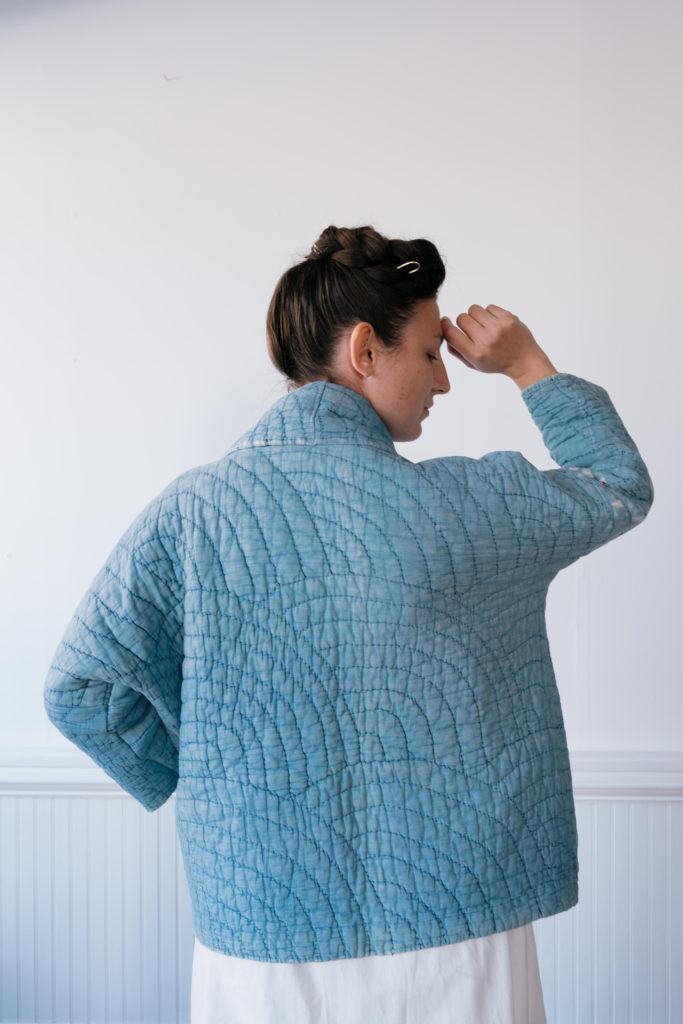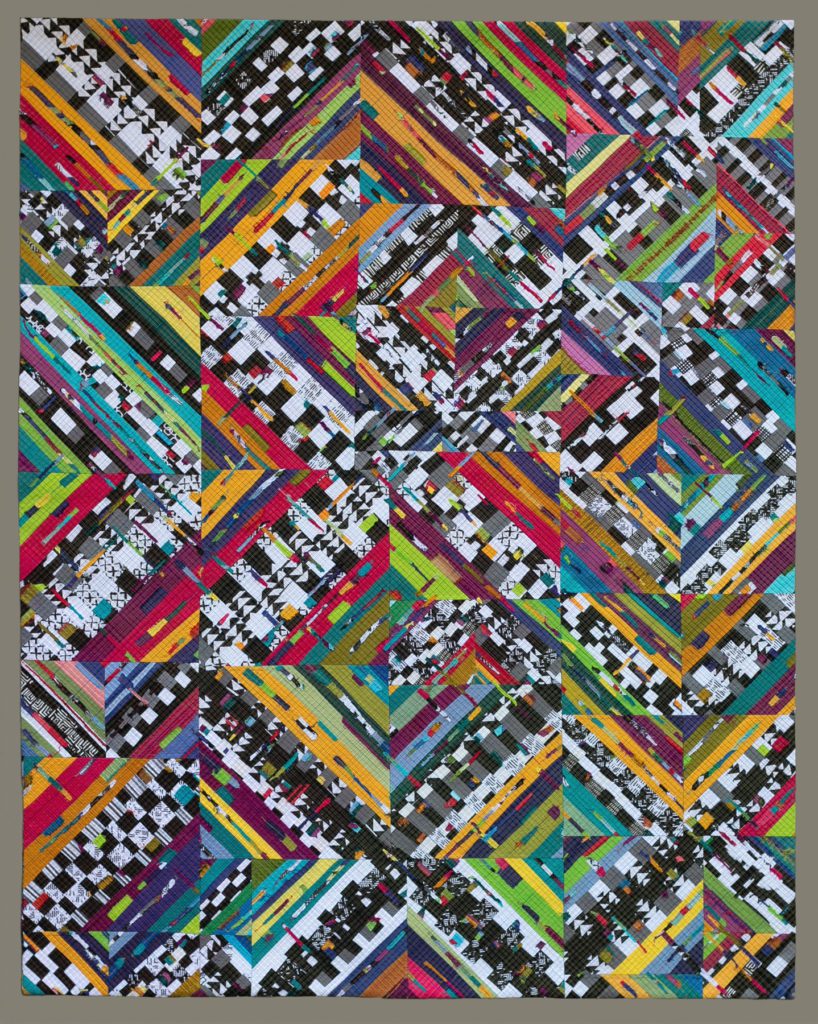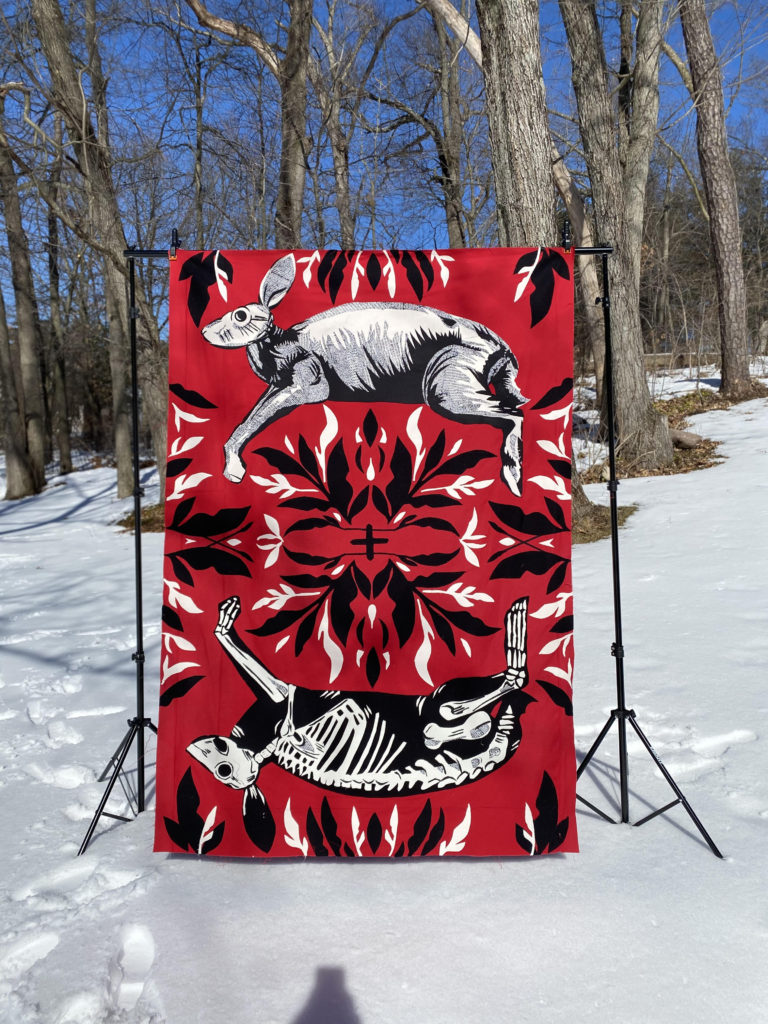In this new showcase I’m featuring four Modern Quilters that you will love! Sarah Durst, Vickie Wheatley, Amanda Nadig, and Cabrini Mary . Enjoy their stories and amazing quilts.
Sarah Durst
I haven’t always been an artist and I’m entirely self-taught. I was an English teacher and instructional coach, finishing a PhD in writing studies when life came to a full stop. My husband’s job changed, my health changed and I found myself moving to the country to begin a life that I had never anticipated or expected. While finishing school, I used pottery and antique textile care/repair as a way to seek peace. At the time, my husband was an antique dealer and would find mountains of worn antique quilts and textiles that families discarded. I knew they needed to be more. I could see the beauty and handiwork and felt as though I could work around the damage to give these pieces new life. And so in 2018, I began drafting and patterning the coat you see today. In October of 2020, I was taking a nap and had a dream in which myself and Leney of Folkling would work together to prodice collections. And The Heritage Quilt Coat Project was born. Leney and I still collaborate on collections, but I have been able to expand to include commission work and produce smaller collections for release as well. As I always say: Redemption is possible. Nothing is wasted. Heed the dreams. Take the risk.

I am immensely inspired by the ever-changing Southern sky, my God, the mountains I can see from my front door, and humanity. My family, my internet community, strangers I meet fill me with such joy – people are truly the most important thing to me and why I do what I do. I want to create simple utilitarian beauty and produce quality, heirloom garments that can continue to connect families through generations of time.
I am always drawn to the deep indigo blues of 1800s calico. The variations in that particular plant dye are fantastic. I am also inspired by the bold geometry of pieced quilts. Nothing speaks to me like the fine lines of fussy quilting in mid to late 1800s quilts.


photo by @agirlnamedleney and Sarah Durst
Vickie Wheatley
Following in the footsteps of generations of women in my family, I learned to sew. I have made clothing, home furnishings, and even camping gear. I learned to embroider, stencil floor cloths, and weave baskets, all while teaching and raising a family. When my daughter left for college in 2000, I made her a quilt from some of her childhood clothing, which caused me to start looking more carefully at quilts. I made a few more bed quilts, using commercial fabrics and other people’s patterns. Somewhere along the line, I discovered Gee’s Bend and Nancy Crow quilts and that led to the whole world of contemporary quilt makers. These were (mostly) women, dyeing their own fabric and working improvisationally to create works of art. I was hooked.
Starting in 2013, I used some excellent resources to teach myself to dye fabric (Frieda Anderson, Jane Dunnewald, Ann Johnston) and understand color (David Hornung, Jane Davies). I am fortunate to live very close to the Carnegie Center for Art and History in New Albany, Indiana where I could see the amazing work of contemporary artists in the show Form Not Function. I studied their compositions and techniques. I was drawn to large, colorful pieced work and surface designed fabrics. In 2017, I started a series titled “Anxieties.” This began as anxieties about myself as an artist, but became more universal in nature as I continued working. All of the pieces in the series are based on a block with a strong (usually black and white) diagonal. In some pieces, these blocks are easy to see. In others, I cut the blocks apart and add gridlines. In all of them, I add tiny little scraps while piecing or quilting that add texture and movement to the pieces. I was thrilled to be included in the Form Not Function show in 2018 and 2019!

I also love hand stitching and I use leftover blocks from my circle series to stitch on. In the future, I’d like to add hand stitching to my larger quilts, along with the tiny scraps. You can see more of my work on my website, vickiewheatley.com, or follow me on Instagram.
WEBSITE Vickie Wheatley


Amanda Nadig
I begin a quilt by sorting through the second hand fabrics in my home studio to discover surprising shapes and interesting juxtapositions: heavy and thin fabrics, opaque and sheer, shiny and flat, textured and smooth, as well as fabrics that are faded paired with those with a high saturation of color. The composition is right when I have achieved the right amount of balance and tension. It was not until 2019 that I developed a daily artistic practice ignited by two inspiring teachers: a class called “Stitch” taught by textile artist Melissa Leandro and a workshop “Quilt in a Day” taught by Heidi Parkes. My experience as a high school art teacher also fuels my work and keeps me experimenting and growing. For example, when my students and I screen print or embroider or make monoprints together in the art classroom, these processes naturally make their way into my work. Currently I’m exploring neons in my work and plan on focusing on some larger scale work, like bed-sized quilts. I’m also reworking some vintage quilt tops with some contemporary fabrics and this is a direction I am also excited about.




Cabrini Mary
I’ve been quilting since 2015, but have been in love with textiles since I was a child.
While I would describe my style as modern, I work frequently with traditional blocks, specifically HSTs. Most of my full sized quilts are not designed in advance. I typically find a color palette I enjoy, make hundreds of HSTs and challenge myself to create different patterns using every block. I will work through 4-5 drafts before finalizing a design. In this way, quilting feels like playing.
I am able to best express my ideas in appliqué and most of my wall hangings are inspired by nature and geometry. I often try to weave in elements of my family’s culture and history into my quilts, with my totem series devoted to the different ways animals and nature appear in Eastern and Western culture. My aesthetic is heavily influenced by Asian design elements. On the cutting table today is a Japanese monkey quilt that explores the use of negative space in my designs.
I had a brief affair with linocut printing and created dozens of designs for repeating stamp patterns. These designs lent themselves perfectly to quilts and is an example of why I enjoy practicing and learning multiple art forms. While textile arts will always be my first love, I enjoy stretching different creative muscles and feel it only adds to my sewing range.

I’m constantly amazed at the beautiful quilts I see everyday in the quilting community. I feel honored to be part of this craft and am so grateful for the amazing artists I’ve met along the way.






